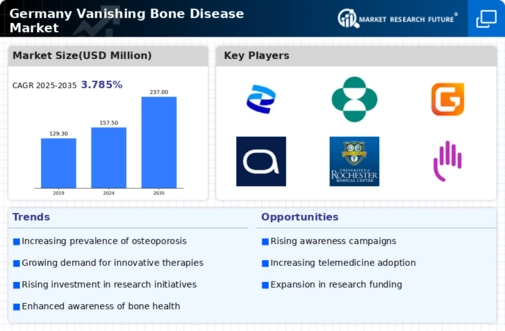Government Initiatives and Support
Government policies and initiatives aimed at improving healthcare access and funding for research are pivotal for the vanishing bone-disease market. In Germany, the government has been actively promoting health programs that focus on bone health, including awareness campaigns and funding for clinical trials. Such initiatives are designed to enhance public understanding of bone diseases and encourage early diagnosis and treatment. The German Federal Ministry of Health has allocated substantial resources to support research in this area, which could lead to the development of new therapies. This supportive environment is likely to foster innovation and growth in the vanishing bone-disease market, as stakeholders collaborate to address the challenges posed by these conditions.
Rising Incidence of Bone Disorders
The increasing prevalence of bone disorders in Germany is a critical driver for the vanishing bone-disease market. Recent studies indicate that conditions such as osteoporosis and osteogenesis imperfecta are becoming more common, particularly among the aging population. This demographic shift suggests a growing need for effective treatments and management strategies. As the population aged 65 and older is projected to reach 23% by 2035, the demand for innovative therapies in the vanishing bone-disease market is likely to escalate. Furthermore, the healthcare system may face increased pressure to provide adequate care, thereby driving investments in research and development. This trend indicates a potential growth trajectory for the market, as healthcare providers seek to address the rising burden of bone-related diseases.
Advancements in Diagnostic Technologies
Technological innovations in diagnostic tools are significantly impacting the vanishing bone-disease market. Enhanced imaging techniques, such as high-resolution MRI and advanced bone density scans, allow for earlier and more accurate detection of bone diseases. These advancements facilitate timely intervention, which is crucial for effective treatment outcomes. The integration of artificial intelligence in diagnostic processes is also emerging, potentially improving the efficiency and accuracy of diagnoses. As healthcare providers in Germany adopt these technologies, the demand for related therapeutic solutions is expected to rise. This shift not only enhances patient care but also stimulates growth within the vanishing bone-disease market, as more individuals are diagnosed and treated for these conditions.
Growing Investment in Biopharmaceuticals
Investment in biopharmaceuticals is emerging as a significant driver for the vanishing bone-disease market. With advancements in biotechnology, there is a growing focus on developing biologic therapies that target specific pathways involved in bone diseases. In Germany, several biopharmaceutical companies are actively engaged in research and development, aiming to bring novel treatments to market. The potential for high returns on investment in this sector is attracting venture capital and funding from both public and private entities. As these investments continue to grow, they are likely to stimulate innovation and expand the range of treatment options available in the vanishing bone-disease market, ultimately improving patient outcomes.
Increased Collaboration Among Stakeholders
The vanishing bone-disease market is witnessing a surge in collaboration among various stakeholders, including pharmaceutical companies, research institutions, and healthcare providers. This trend is driven by the recognition that addressing complex bone diseases requires a multifaceted approach. Partnerships are forming to facilitate the sharing of knowledge, resources, and expertise, which can accelerate the development of new treatments. Additionally, collaborative efforts in clinical research are likely to enhance the understanding of disease mechanisms and improve therapeutic strategies. As these partnerships strengthen, they may lead to innovative solutions that address unmet needs in the vanishing bone-disease market, ultimately benefiting patients and healthcare systems alike.
























Leave a Comment